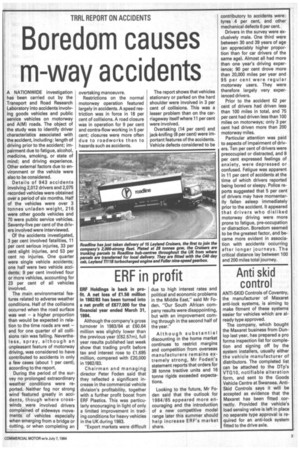Boredom causes mi-way accidents
Page 5

If you've noticed an error in this article please click here to report it so we can fix it.
A NATIONWIDE investigation has been carried out by the Transport and Road Research Laboratory into accidents involving goods vehicles and public service vehicles on motorway and A(M) roads. The object of the study was to identify driver characteristics associated with the accident, including: length of driving prior to the accident; impairment due to fatigue, alcohol, medicine, smoking, or state of mind; and driving experience. Other external factors due to environment or the vehicle were also to be considered.
Details of 943 accidents involving 2,012 drivers and 2,075 recorded vehicles were obtained over a period of six months. Half of the vehicles were over 3 tonnes unladen weight, 216 were other goods vehicles and 70 were public service vehicles. Seventy-five per cent of the drivers involved were interviewed.
Of the accidents investigated, 3 per cent involved fatalities, 11 per cent serious injuries, 33 per cent slight injuries, and 53 per cent no injuries. One quarter were single vehicle accidents; one half were two vehicle accidents; 9 per cent involved four or more vehicles, accounting for 23 per cent of all vehicles involved.
The main environmental features related to adverse weather conditions. Half of the collisions occurred when the road surface was wet — a higher proportion than would be expected in relation to the time roads are wet — and for one quarter of all collisions rain was falling. Nevertheless, spray, although an unpleasant feature of motorway driving, was considered to have contributed to accidents in only a few cases (about 1 per cent), according to the report.
During the period of the survey no prolonged extraordinary weather conditions were reported. Neither fog nor strong wind featured greatly in accidents, though where crosswinds were involved drivers complained of sideways movements of vehicles especially when emerging from a bridge or cutting, or when completing an overtaking manoeuvre.
Restrictions on the normal motorway operation featured largely in accidents. A speed restriction was in force in 18 per cent of collisions. A road closure was in operation for 9 per cent and contra-flow working in 5 per cent; closures were more often due to roadworks than to hazards such as accidents. The report shows that vehicles stationary or parked on the hard shoulder were involved in 3 per cent of collisions. This was a lesser problem than on the carriageway itself where 11 per cent were involved.
Overtaking (14 per cent) and jack-knifing (8 per cent) were important features of the accidents. Vehicle defects considered to be contributory to accidents were: tyres 4 per cent, and other mechanical defects 6 per cent.
Drivers in the survey were exclusively male. One third were between 30 and 39 years of age (an appreciably higher proportion than for car drivers of the same age). Almost all had more than one year's driving experience; 90 per cent drove more than 20,000 miles per year and 95 per cent were regular motorway users. They were therefore largely very experienced drivers.
Prior to the accident 62 per cent of drivers had driven less than 100 miles in total, and 75 per cent had driven less than 100 miles on motorways; only 3 per cent had driven more than 200 motorway miles.
Particular attention was paid to aspects of impairment of drivers. Ten per cent of drivers were preoccupied or distracted, and 8 per cent expressed feelings of anxiety, were depressed or confused. Fatigue was apparent in 11 per cent of accidents at the time of which drivers reported being bored or sleepy. Police reports suggested that 5 per cent of drivers may have momentarily fallen asleep immediately prior to the accident. It appeared that drivers who disliked motorway driving were more prone to fatigue, pre-occupation or distraction. Boredom seemed to be the greatest factor, and became more evident in association with accidents occurring after longer journeys. The critical distance lay between 100 and 200 miles total journey.




























































































